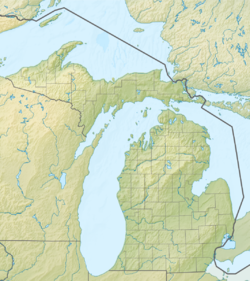History
Establishment
Straits State Park was established in 1924 as a simple day park with the entrance located at the corner of Paro and Hombach street. In the mid-1940s the park was redesigned to allow for approximately 32 tent campsites along the shores of the Straits of Mackinac. Around this time, the entrance to the park changed to the corner of Paro and Church street.
1950s expansion and Mackinac Bridge impact
In the early 1950s the park expanded north and about 90 new campsites were created to accommodate traveling campers and their travel trailers in the southern park along the Straits of Mackinac. The park entrance remained the same as it was easily accessible to travelers arriving in St. Ignace from the Lower Peninsula by way of the car ferry which docked only a half mile east of the park. The new northern land was left undeveloped.
In the mid-1950s construction began on the Mackinac Bridge and its approaches. The road, however, was designed to cut through the center of the northern park expansion. [2] In a compromise, it was agreed that a pedestrian bridge would be erected over the new road connecting the two parts. However, that bridge was never built. Additionally, original concepts called for a Mackinac Bridge Museum to be constructed at the northern end of the bridge thus cutting away more park land. The land for the museum was allowed to be annexed but no museum was ever built. Currently, it is the Upper Peninsula Welcome Center.
1970s renovations and Marquette memorial
In the mid-1970s the park entrance was moved approximately 300 feet (91 m) north on Church street to its current location, the park restroom facilities were updated, and the lower park was expanded to nearly 130 campsites while the upper park was developed into nearly 145 sites and all site were equipped with electricity. Also at this time, the bridge overlook area and trail to the upper park were created.
In 1975 the decision was made to create the Father Marquette National Memorial, in the park area west of Interstate 75. Again, it was decided to erect a pedestrian bridge across the highway to the park. The memorial and museum opened in 1980 along with interpretive trails, however no pedestrian bridge was created. In 2000 the museum was struck by lightning and burned to the ground.
2000s renovations
In 2003 and 2004 the Parks Division of the Michigan Department of Natural Resources did renovations on the campground, closing the park for much of that period. The plan called for new facilities at all 5 bathrooms, and updating each campsite with 20, 30, and 50 amp electrical service and a level camping pad. The popular campsites along the lake shoreline were closed, bringing the number of sites to 255. However some of those sites were later reopened.
This page is based on this
Wikipedia article Text is available under the
CC BY-SA 4.0 license; additional terms may apply.
Images, videos and audio are available under their respective licenses.


